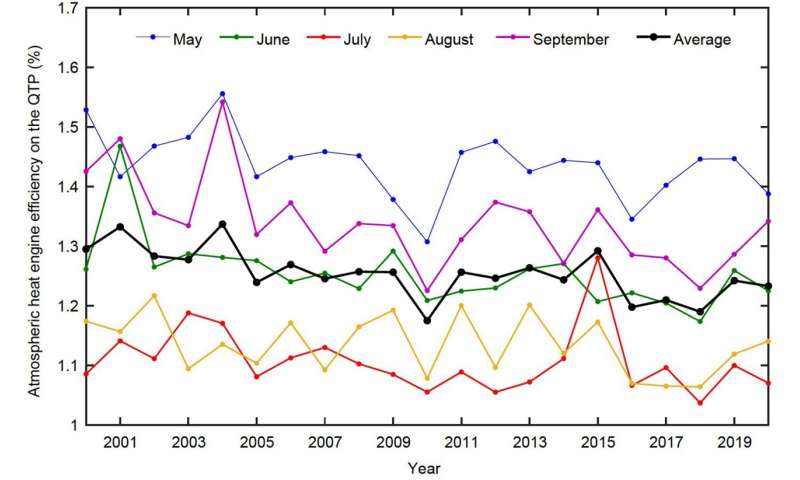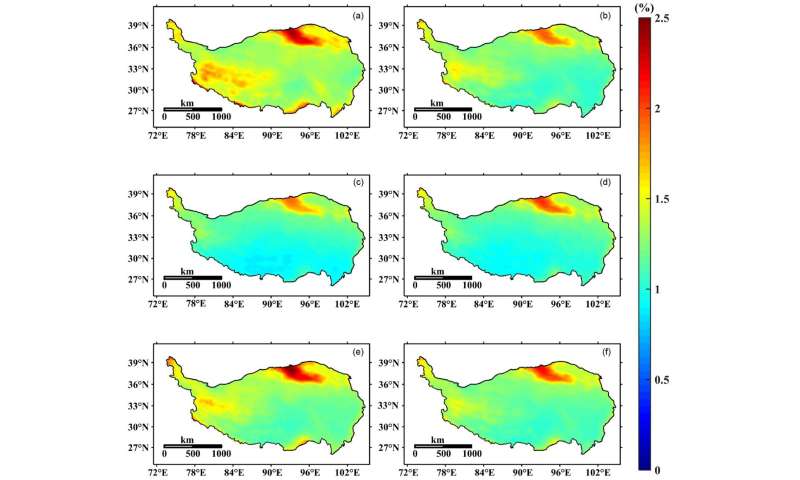Heat engine efficiency of the system over the Qinghai-Tibetan Plateau in summer may be the highest in the world

This study was led by Prof. Xiaoqing Gao (Northwest Institute of Eco-Environment and Resources, Chinese Academy of Sciences) and Prof. Yaoming Ma (Institute of Tibetan Plateau Research, Chinese Academy of Sciences). Climate change has a broad and far-reaching impact on the sustainable development of mankind.
It is closely linked to most of the UN's Sustainable Development Goals (SDGs). "To study land-air interaction on Qinghai-Tibetan Plateau (QTP) is the key to understanding the importance of the QTP to climate change regional and global," Ma says.
Gao and Ma, together with Dr. Yujie Li et al., sought to determine the comprehensive effect of land-air interaction on the QTP. The team defined an index, i.e., atmospheric heat engine efficiency(AHEE), to represent the comprehensive energy transformation efficiency of land-air interaction and performed the analysis on the spatial and temporal characteristics of AHEE on the QTP by using multi-source data for 2000-2020.
The team found that the AHEE on The QTP in summer (May- September) (1.2-1.5%) is much bigger than that of the tropical Hadley circulation, ranging from approximately 0.3% to 0.4%, and the modern plateau monsoon heat engine efficiency in the western United States, at 0.7%. "This result is astonishing, because it means that the land-air system on the QTP is such a high-performance heat engine around world. It might produce atmospheric energy with the highest efficiency globally," Gao says.

The researchers also revealed the spatial and temporal variations of the AHEE on the QTP in the past two decades. The QTP summer AHEE shows a wavy decreasing trend in the past two decades. The highest months in summer period are May and September,i.e. the establishing and decaying months of the QTP summer monsoon. Qaidam Basin is the region with the highest atmospheric heat engine efficiency, followed by the western QTP.
Lorenz (1967) et al. used the concept of the heat engine to explain the energy-water cycle between land and air. It has been shown that the efficiency of a general natural atmospheric heat engine is less than 1%. But this work reveals that the QTP region has a unique and much higher AHEE.
This new result shows new evidence to support that the QTP is a pioneering region in climate change for its high AHEE and large scale. This work lays a more robust foundation for future effort to understanding the impact of the QTP on climate change regional and globally.
The work is published in the journal Science China Earth Sciences.
More information:
Yujie Li et al, Study on the atmospheric heat engine efficiency and heat source characteristics of the Qinghai-Tibet Plateau in summer, Science China Earth Sciences (2023). DOI: 10.1007/s11430-023-1212-3
Provided by Science China Press